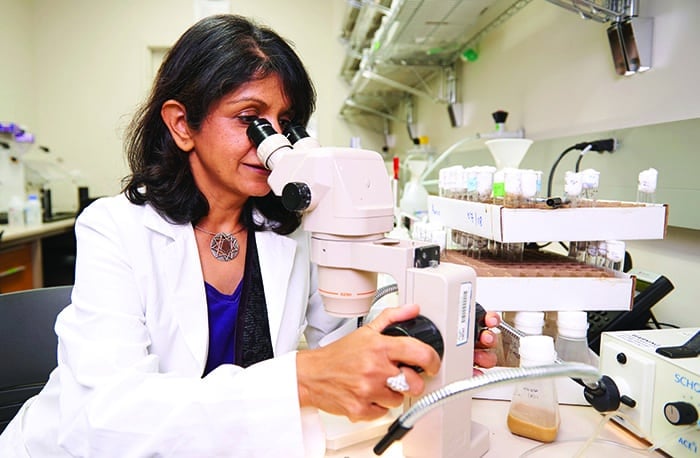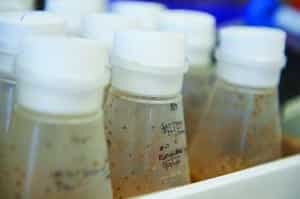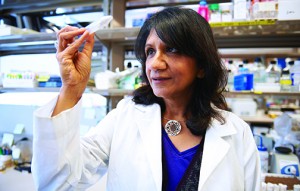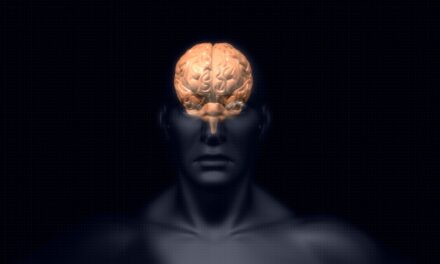Amita Sehgal, PhD, unravels the mysteries of circadian rhythms. And the common fruit fly is her unlikely research subject.
Circadian rhythms are one of the hottest subjects today in sleep medicine. With a greater understanding of what circadian rhythms are and how they are crucial for better sleep and health, sleep physicians are finding more ways to help patients with sleep disorders.
While physicians make strides in treating patients, researchers such as Amita Sehgal, PhD, the John Herr Musser Professor of Neuroscience, investigator at the Howard Hughes Medical Institute (HHMI), and director of the Chronobiology Program, Perelman School of Medicine, University of Pennsylvania, delve into the mysteries of circadian rhythms and are finding revelatory reasons as to how and why circadian rhythms work.
And in one sense, the answer is simple: clocks.
“I would say the ‘aha’ moments that have fueled current interest were the discovery of the clock mechanism and the revelation that clocks are everywhere in the body, driving many processes with a circadian rhythm,” Sehgal says. “We basically now know that most physiological processes are cycling.”
But it’s the results of these “aha” moments that have made Sehgal’s work groundbreaking. And much of her ability to make new discoveries is thanks to a surprising research subject.
Time (and) Flies
While Sehgal’s accomplishments have significant implications for human health, many of her discoveries were thanks to an understanding of an unlikely research subject—Drosophila melanogaster. In other words, the common fruit fly.
While the use of an insectoid research subject instead of a more common (and perhaps expected) mammalian research subject may seem counterintuitive, Sehgal explains that the fruit fly is actually the perfect research subject.
“Mechanisms of the circadian clock were first identified in fruit flies and found to be conserved in mammals, including humans,” she says. “In fact, specific clock genes identified in flies are now linked to human circadian disorders.”
For example, mutations in some of these clock genes account for advanced sleep phase syndrome in some families. The syndrome causes patients to feel very sleepy early in the evening and causes them to wake up early in the morning. Treatment includes light therapy.
There’s a fundamental, practical reason that fruit flies are the perfect model for researchers to use for the study of circadian rhythms. “The major reason we work with flies is because they are a great model for genetics,” Sehgal says. “Unbiased genetic screens are much faster and have higher throughput in the fly, due to the shorter generation time as well as ease—and low expense—of breeding and maintaining flies.”
The genes of the fruit flies are much easier to manipulate than in mammals, and the consequences are also more easily observed.
For instance, according to her biography on the HHMI website, Sehgal and her team members were able to tweak the so-called “timeless gene”—which synchronizes the fly’s 24-hour physiological cycle with environmental clues (in this case, daylight).1 Lack of the gene disrupts the internal clock’s ability to keep time. By manipulating the fruit fly’s clock genes (timeless or its partner, period) to set on a non-24-hour cycle, it suggested that the time span of the clock is genetic.
The success of the fly for identifying mechanisms that generate a circadian clock prompted Sehgal and her colleagues to determine if flies could be used to study how and why the need for sleep is regulated. The simpler genetics of the fruit fly helps researchers get the kind of insights that might be challenging if mammalian models were studied instead. “It can be difficult to get strong effects of mutations in sleep genes [in mammals], because the animal will compensate to restore sleep amount, probably because sleep is essential,” Sehgal says. “However, flies have much less genetic redundancy and therefore cannot compensate as effectively; as a result, one can get stronger mutant phenotypes. We are also interested in tracing neural circuits that drive sleep. Although fly anatomy is different from mammalian, we believe principles will be conserved.”
One of Sehgal’s breakthroughs in using fruit flies came when she identified a signaling pathway that controls sleep in the insects, and acts in a region called the mushroom body, which also regulates learning and memory, according to her HHMI biography. This discovery meant that the fruit fly would be a perfect model to use in studying the link between sleep and learning.
Even though they are a different species, Sehgal notes that the sleep discoveries made in studying fruit flies can have translational benefits for humans, because there are surprising similarities between fruit flies and humans. “There are some differences [between flies and mammals], but we believe many mechanisms will be conserved, as they are for circadian rhythms. Fly sleep can be modulated by the same neurochemicals and drugs as mammalian/human sleep,” she says. “Also, some sleep genes found in flies are already implicated in human sleep.”
Sehgal and her team are also getting a better understanding of the brain by studying the fruit fly. For instance, one neural circuit that Sehgal and her team have already identified is the fly version of the human brain protein corticotrophin releasing factor (CRF).2 According to a summary of the study by the University of Pennsylvania, the fly version, named DH44, is required for rest/activity cycles. It originates in cells that receive input from the clock cells. In mammals, CRF is secreted rhythmically and it drives the expression of glucocorticoids, including cortisol.
Sehgal’s research into circadian rhythms and sleep has resulted in a long list of discoveries and accomplishments, including identification and cloning of the timeless gene (also known as the second clock gene), discovery of the mechanisms that entrain the fruit fly clock to light—a first for an animal clock, the circuits that connect the brain clock to behavioral output, discovery of genes in the output pathway, development of a Drosophila model for sleep homeostasis, and discovery of genes and circuits that control sleep amount.
Fascinating Rhythm
[metaslider id=158376]
Sehgal’s interest in circadian rhythms began when she was studying molecular biology at Cornell University in New York City. “In grad school, I was fascinated by the idea of studying the molecular basis of behavior,” she says.
However, her training was at odds with this ambition. Particularly, since, at the time of her studies, molecular biology was primarily concerned with qualitative changes. Behavior didn’t fit this model, since it’s “very variable and inconsistent,” she explains.
Seeing circadian rhythm data for the first time was the molecular biology grad student’s own “aha” moment. “I realized this was something I could get into,” she says. “The behavior is very robust and stereotyped, and lends itself beautifully to cellular and molecular analysis.”
Aversion to Science
Surprisingly, Sehgal, who has spent time in the spotlight with the likes of science proponent Neil Degrasse Tyson, did her utmost to avoid a career in what seems, in hindsight with her array of discoveries, almost a fait accompli.
Born in Delhi, India, Sehgal spent her childhood moving across the globe from such diverse points on the map as Germany, Kolkata, and Kashmir, due to her father’s job with the Indian government, which had the family moving about every 3 years.
Returning to Delhi to attend college, Sehgal became very interested in English literature. But a number of influences that were a combination of peer pressure, family expectations, and the advice of friends had her continually returning to science during her formative years in high school and college.
Prior to heading to graduate school to study molecular biology, a few months volunteering in a lab in Perth, Australia (where her father’s current government posting had taken the family), on a project to determine if DNA repair was affected in people with muscular dystrophy, seemingly sealed her distaste for science.
But in graduate school at Cornell an unexpected transformation occurred. “While in grad school, I started to love science,” she says.
Sehgal did her postdoctorate work from 1988 to 1993 at Rockefeller University. It was there, according to her HHMI biography, working with Michael Young, that she began her work with circadian rhythms.
Today, the young woman who initially wanted nothing to do with science is the head of a lab bearing her name, leading a team of accomplished researchers who are studying the molecular basis of behavior with a major emphasis on circadian rhythms.
The study of circadian rhythms is only one of Sehgal’s interests. The lab is also studying sleep homeostasis. “This relates to sleep need—why we have sleep need, how this is met, and what controls sleep amount,” she says. “It’s important to distinguish between circadian rhythms and circadian control of sleep, which basically accounts for sleep timing, and homeostatic regulation of sleep. The latter relates to sleep amount and quality, and the crash one experiences when one hasn’t slept.”
Timing Is Everything
Time and synchronicity is an important element in Sehgal’s research, and it has implications for day-to-day life beyond the quality of sleep. In her view—relating back to her training in biology—every aspect of human life has to be in sync.
“It is important that physiological processes be synchronized to the environmental cycle and with each other,” she says. “For optimal health, everything—such as sleep, food intake, drug delivery—must be appropriately timed. We also know that circadian rhythms can vary from person to person. Taking this into account in assigning jobs and work schedule could greatly affect productivity.”
As for the future of sleep research, Sehgal foresees that researchers will have a deeper understanding of sleep and other biological processes. “I think sleep will be linked to more and more physiological processes,” she says. “Until recently, sleep research was very brain-centric. Now we recognize sleep as very relevant for metabolism. In the future, we’ll see mechanistic links to other processes.”
Working on the profile of Amita Sehgal made C.A. Wolski nostalgic for his own days dabbling in behavioral science—his graduate studies were underpinned by cognitive behavior—and he is looking forward to Dr Sehgal’s next discovery.
References
1. Hunter-Ensor M, Ousley A, Sehgal A. Regulation of the Drosophila protein Timeless suggests a mechanism for resetting the circadian clock by light. Cell. 8 March 1996;84(5):677–85.
2. Cavanaugh DJ, Geratowski JD, Wooltorton JRA, Spaethling JM, Hector CE, Zheng X, Johnson EC, Eberwine JH, Sehgal A. Identification of a circadian output circuit for rest: activity rhythms in Drosophila. Cell. 24 April 2014;157(3):689–701.










